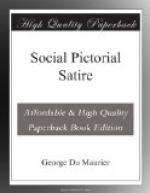The other critic is the expert, our fellow-craftsman, who has learned by initiation, apprenticeship, and long practice the simple secrets of our common trade. He is not quite infallible either, and is apt to concern himself more about the manner than the matter of our performance; nor is he of immediate importance, since with the public on our side we can do without him for a while, and flourish like a green bay-tree in spite of his artistic disapproval of our work; but he is not to be despised, for he is some years in advance of that other critic, the public, who may, and probably will, come round to his way of thinking in time.
The first of these two critics is typified by Moliere’s famous cook, who must have been a singularly honest, independent, and intelligent person, since he chose in all cases to abide by her decision, and not with an altogether unsatisfactory result to Mankind! Such cooks are not to be found in these days—certainly not in England; but he is an unlucky craftsman who does not possess some such natural critics in his family, his home, or near it—mother, sister, friend, wife, or child—who will look over his shoulder at his little sketch, and say:
“Tommy [or Papa, or Grandpapa, as the case may be], that person you’ve just drawn doesn’t look quite natural,” or:
“That lady is not properly dressed for the person you want her to be—those hats are not worn this year,” and so forth and so forth.
When you have thoroughly satisfied this household critic, then is the time to show some handy brother-craftsman your amended work, and listen gratefully when he suggests that you should put a tone on this wall, and a tree, or something, in the left middle distance to balance the composition, and raise or depress the horizon-line to get a better effect of perspective.
In speaking of some of my fellow-artists on Punch, and of their work, I shall try and bring both these critical methods into play—promising, however, once for all, that such criticism on my part is simply the expression of my individual taste or fancy, the taste or fancy of one who by no means pretends to the unerring acumen of Moliere’s cook, on the one hand, and who feels himself by no means infallible in his judgment of purely technical matters, on the other. I can only admire and say why, or why I don’t; and if I fail in making you admire and disadmire with me, it will most likely be my fault as well as my misfortune.
I had originally proposed to treat of Richard Doyle, John Leech, and Charles Keene—and finally of myself, since that I should speak of myself was rather insisted upon by those who procured me the honour of speaking at all. I find, however, that there is so much to say about Leech and Keene that I have thought it better to sacrifice Richard Doyle, who belongs to a remoter period, and whose work, exquisite as it is of its kind, is so much slighter than theirs, and fills so much less of the public eye; for his connection with Punch did not last long. Moreover, personally I knew less of him: just enough to find that to know was to love him—a happy peculiarity he shared with his two great collaborators on Punch.




